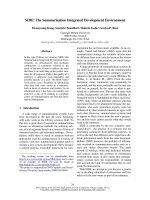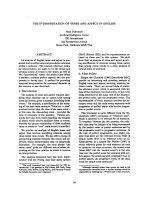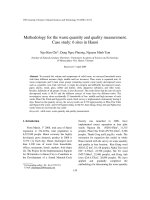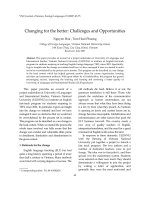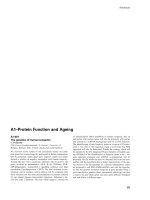Báo cáo " Changing for the better: Challenges and Opportunities" pptx
Bạn đang xem bản rút gọn của tài liệu. Xem và tải ngay bản đầy đủ của tài liệu tại đây (285.28 KB, 11 trang )
VNUJournalofScience,Foreign Languages23(2007)65‐75
65
Changingforthebetter:ChallengesandOpportunities
NguyenHoa
*
,TranHoaiPhuong
CollegeofForeignLanguages,VietnamNationalUniversity,Hanoi,
144XuanThuy,CauGiay,Hanoi,Vietnam
Received1June2007
Abstract.ThispaperprovidesanaccountofaprojectundertakenatUniversityofLanguagesand
International Studies, Vietnam National University (ULISVNU) to institute an English fast‐track
programforstudentsmajoringinteachingEnglishforeignlanguage(TEFL)since2001.Specifically,
itgivesinsightsintothechangeweinitiatedandhowwe
havemanageditoncewestartedinorder
nottobeoverwhelmedbytheprocesssetinmotion.Thisprogramcanbedescribedasaseachange
in the local context which has helped generate creative ideas for course organization, learning
activitiesandassessmentmethods.Withgreateffortsbyall
stakeholders,theprogramhasgained
encouraging success, improving the teaching and learning and rendering a better quality of
UniversityofLanguagesandInternationalStudies(ULIS)graduates.
This
*
paper provides an account of a
projectundertakenatUniversityofLanguages
and International Studies, Vietnam National
University(ULISVNU)toinstituteanEnglish
fast‐track program for students majoring in
TEFLsince2001.Inparticular,itgivesaninsight
into the change we initiated and how we have
managedit
oncewestartedsothatwewouldnot
be overwhelmed by the process set in motion.
Thisprogramcanbedescribedasaseachang ein
thelocalcontext.Whenwestartedtheprocessthe
whole team involved was fully aware that this
changewasatenderandvulnerableaffair,prone
to derailment, diminution and abandonment in
thegivencontext.
1.Rationaleforthechange
English language teaching (ELT) has had
quitealonghistoryspanningaperiodofmore
thanhalfacenturyinVietnam.Manymethods
weretriedwithvaryingdegreesofsuccess.The
_____
* Correspondingauth o r.Tel.:84‐4‐8582630.
old methods die hard. Believe it or not, the
grammar translation is still there. Those who
preach the usefulness of the communicative
approach or learner centeredness are not
alwaysawarethatwhatth eyhavebeendoing
isafarcryfromwhattheypreach.AsVietnam
isopeningit sdoor s and
marketforces arein,
changebecomesinescapable.Globalizationan d
informatiz ati onareotherfactorsthat pushth e
ELT business forward. The country needs a
new crop of quality teachers of English,
interpreters/translators,andtheneedforagood
commandof Englishisfeltacross theland.
In response to these demands,
ULISVNU
with the blessing of Vietnam National
University put together a project to launch a
fast track program. The two authors and a
number of dedicated teachers were in put
charge.Theideawastofirstpilotit,andthen
spreaditto the mainstream system.Students
wereselectedontheir
ownmerit:theyshould
demonstrate a willingness to join the project
by writing a letter of application, and
generally they were the most motivated and
NguyenHoa,TranHoa i Phuong/VNU Jour nalofSc ien c e , ForeignLangua ges23(2007)65‐75
66
talented ones from the student body. Class
size was 20 students. Screening involved
studying their academic records and
subjecting them to a selection tes t. Teachers
were also carefully selected. All the team
membersweretrainedinanEnglishspeaking
country and have a Master’s d egree. All of
themshouldhaveprior
experienceworkingin
awesternstyleenvironment.Wecameto the
taskwithhu milityandre solve,knowingthat
many previous attempts failed; for example,
the large scale effort at changing teacher’s
teachingmethodsinthe1990swasnotfruitful
due to inadequate conceptualization and
supportaswellasinsufficientfollow‐
upwork,
resourcesandappropriatepolicies.Theysimply
introduced a model from outside and flew
professionals with high credentials in and out
withouttakingthelocalcontextintoa ccount.
2.Theblueprintandplanningstage
The final go‐ahead wa s given and we
started the conceptualization and planning
process. Jack Lindquist [1] mentions four
change strategies, which are rational planning,
social interaction, human problem‐solving and
politicalappr oach.WhatLi ndquist discussesis
very insightful and int eresting. In every
organization, there will be a few innovators,
eagertochangeandreinventthemselves,and
usuallyuncomfort ablewiththestatusquo.A
secondgroup
ofabout12to15percentofthe
organizationiscalledtheearlyadopters,open
tonewideasandchanges,thoughnotaseager
as the innovators. Following is the early
majority,makingupathirdofthepopulation.
These are the cautious followers of the
early adopters.Thencomesanother
third,
theso‐calledskepticallatemajo rity,which
wants fairly impressive evidence that the
changeisworking,possible,andrewarded
beforetheyventurea try.Finally,abo ut15
percent of most organizations are the
laggards, who will probably resist change
until everyone is doing the next new
things. Lindquist’s observations
are quite
trueinourco ntext.
Given our culture much influenced by
Confucianism, Budd hism and Taois m, we
decidedonthesocial interactionapproach.We
implemented and managed the change as a
social interaction where ide as should be
communicated to people, and contacts,
consultations,andpersuasionswereeffectivein
bringingpeopleround
toourview.Anumberof
workshopswereheldamo ngtheteammembers
wherewediscussedthefollowingissues:
(a) Whatisourphilosophyregarding the
organizingofafasttrackcourse?
(b )Whatstandar dsshouldweaimforinterms
ofknowledge,ski lls,andqualities/ch aracters?
(c) What should
be our approach to
deliveringthegoods?
(d)Howshouldwemonitorourprogress
and incorporate feedbac k into the project as
appropriate?
(e)Whatsortsoflikelyconstraintsarethere?
Definingan underlyingphilosophywasa
break from tradi tion si nce in this country
training program sareoften de finedin terms
of
aims and objectives. We believed that a
philosophyclearl ydefinedwouldhelpanswer
question(b),i.e.whatstandardsweshouldgo
for in terms of knowledge, skills and
qualities/characters. A philosophy would
serve as a framework to set educational
standards and assessment criteria, and to
outlinewhatthemostimportant
goalswereto
achieve,andwhatresourceswererequiredfor
theachievementofthoseeducationalaims.As
Fuhrmann [2] excellently summarizes the
major educational philosophies as we were
abouttoenterthenewmillennium.Thisearly
decision was extremely usef ul in helping us
designthekindofprogramwewanted.Also,
the choice of teaching course books, and
preparation of materials is much facilitated.
Basically, we agreed that our philosophy
underscoredthefollowingthings
NguyenHoa,TranHoa i Phuong/VNU Jour nalofSc ien c e , ForeignLangua ges23(2007)65‐75
67
. Career preparation is an expected
outcomeofacollegeeducation,
.Collegeshoulddevelopstudents’problem
solving and decision making, evaluating, and
interactionalorinterpersonalskills,
.Studentsmustlearnhowtomanagechange,
.Studentscanlearnin avariety ofways;
allmustbeunderstoodandfostered,
.
Students must able to use IT and other
technologies,
. Students should learn to interact in a
varietyofculturale nvironments , and
.Education is alifelongprocess.
2.1.Settingthestandards
Thus the standards we set for our pilo t
project were very high. Students must reach
thelevelfour
oftheALTE’sorCambridge’s
(1)
CAEafterabout900hoursofEnglishteaching
andlearning.(Allthe studentshad300hours
ofEnglishattheir hi ghschools). Ouranswer
to question (b) was defined in terms of
knowledgeofEnglishandculturerequiredby
the representational, interpretive and
interpersonal skills. For example, students
should develop
the ability to interact both
propositionally and interpersonally. They
should have acquired the ability to make
assessment,orevaluations,toworkinateam
andtobeabletodealwithbothacademicand
emotional issues. Discussions were made to
clarifywhatismeantbyacquiringknowledge,
forexample.We followe d
Bloom ’staxonomy
[3] of educational goals. According to him,
educational goals can be defined in terms of
cognitive,motorskillsandaffectivegoals.On
the cognitive scale, there are 6 levels:
knowledge, comprehension, application,
analysis,synthesis,andevaluation.Atthetop
_____
(1)
TheCambridge sy stem has fivebands: KEY,PET,
FCE, CAE, and Proficiency, corresponding to the
ALTE’s Waystage, Threshold, In dependent,
Competent,andGood.
end,studentsshouldbeabletolookatissues
critically,andmakewell‐informedevaluation
and assessment. Skills devel opment and the
interpersonal skills were given special
attention right at the start to make sure the
students would grow and develop into the
typewesetout.Onthisbasis,learner‐centered
activities were designed to help students
acquireknowledgeanddeveloptheirskills.In
setting these goals, we took into account a
number of factors such as the market’s
demands for our products, the government’s
overall development goals, as well the
availability of resources, both financial and
otherwise. Without these inputs,
it would be
impossibletorealizeourpr og ram .
2.2.Ourchosen approach
It is common know ledge that no matter
howclearouraimsandobjectivesare,thekey
to success is dependent to a large degree on
ourapproachtodeliveringthegoods.Aftera
number of meetings, we discussed how
to
dealwiththeproblem,andweallagreedthat
the best way forward was to translate the
concept of learner’s autonomy and learner‐
centeredness into action. The world we are
living and working in now is very differen t
fromwhatwewerefamiliarwith.Knowledge
is exploding and becoming
more specialized
and highly technical. Knowledge also has a
short shelf life, too. Thusanyapproach based
on giving knowledge is doom ed to failure.
Students need to be equipped with
competencies,skills andsuitableq ualitiessothat
theycansurviveandthriveinanever‐changing
environment.It’slearner‐centeredness,stupid!
Thisiswhatweoftensaidtoeachother.The
students involved in ourprojecthaveturned
out to be great resources. We gave them the
opportunitiestoshowwhattheywereworth,
and most of them
(2)
proved extremely
_____
(2)
One ofthemdropped outfor failingto rise tothe
challengeoftheproject.
NguyenHoa,TranHoa i Phuong/VNU Jour nalofSc ien c e , ForeignLangua ges23(2007)65‐75
68
competent to design learning materials, and
capableofmakingcontributiontothesuccess
oftheproject.Thuswesuccessfullylaidouta
good foundation for a cooperative,
collaborative, peer‐interactive learning and
tutoring.This isour firstlesson: kee pgoing once
youbelievewhatyouaredoingisright,anddevelop
appropriatean dsuitablemethodsofdelivery.
2.3.Defininggoodeffectivelearn ers
Anotherissuewelookedatwasdefininga
good, independent learner. Knowing their
characteristics would help us a great deal in
designingsuitableprogramswithappro p riate
activities for them. We concur with Hedge
(2000: 76), who characterizes a good,
competentlearnerasonewhois
(a) aware of their study needs and can
workwithteacherstoachievetheirgoals.
(b)abletost udybothwithin andwithout
theclassroom.
(c)abletofurtherdevelopwhattheyhave
learnedinclass.
(d)proactiveintheirlearning.
(e) capable of adapting
their learning
strategies to suit their needs and make
learningmoreeffective.
(f)abletomanagetheirtime,and
(g)notdependentonteacher’sinputs.
This served us well since this was the
change we wanted to ma ke in students. To
startwiththiswasnoeasy task.
3.Anticipating
implementationproblemstage
3.1.Somegeneralandstructuralconstraints
Anticipating implementation problems
and constraints was important, too. We
encountered some faculty resistance and
unfavorable feelings in the beginning.
Structurally, moving teachers around was
unthinkable in a culture where stability is
generally desirable. But we knew then that
this was something unavoidable
in any
organization as Jack Lindquist suggests we
should be prepared for. Working in such a
context, teachers should be encouraged and
supported timely, getting all the resources
they needed. Very critical in this connection
was the fact that we all enjoyed the strong
backing of the top leadership of
our College
and the Viet nam National University with
which our College is affiliated and they still
continue to do so. The backing of the top
leadershipwasinstrumentalinkeepingtheproject
ontrack.Thisisournextlesson.
3.2.Settingtherecordstraight
There has been a lot of misunderstanding
about learner’s autonomy and learner‐
centeredness;as aresult,theywerediscredited
insomecircle sof professionals.Somestaffswere
skepticalofwhetherourplanwouldwork.They
made unflattering comments such as: “This is
nothingnov el.We triedit before, and it didn’t
work”.Somewereevenwaitingfor
atimewhen
they could utter “I told you so”. Th is was
discouraging for some people, but we did not
give up. We were resolved to get people to
understand the concept and the reality by
strivingtodoagood job.
Wemanaged tocreatemo refollowersby
starting small,
keeping a low prof ile, and
determinedtomakeourworkasuccessright
from the start . The success and students’
words would speak for us, and this strategy
was working. More students were interested
in our fast track project, and wanted to join.
We could not accept all of them,
so at the
beginning of each new academic year, a
qualifying test was given to decide who
would be invited to participate in the
program. This is our third lesson: be realistic
andkeepalowprofilewhenyouarejuststartingto
avoidunnecessarypublicity.
3.3.Staffingproblem
This
is one of the issues that we
anticipatedveryearlyonwouldhappen.Like
NguyenHoa,TranHoa i Phuong/VNU Jour nalofSc ien c e , ForeignLangua ges23(2007)65‐75
69
us at the beginning of the project, they were
giventraining inthemethodsofdeliveringthe
course, and we made sure that they were in
step wi th us. Some left the project either to
study overseas or move on to other
assignmentsasdictatedbythecircumstances,
and others joined
us. There has never been a
manpower vacuum. This is very important to
ensureconsistencyandqual ity.
4.Theimplementationstage
Whatever design we might have brought
totheprogramandwhatever importance we
mighthaveattachedtotheconcept stage,we
were aware that the implementation was far
more
importantandthatitwasthekeytothe
successoftheproject.Studentsshouldbeable
toparticipatein well‐designed,well‐organi zed
activities andlearningexperien cessetforthem,
and we could really become the type of
facilitatorsthatwealwaystalkedabo ut.
Teamworkwasencoura g edandstudents
found themselves working in an open and
relaxed but serious manner. Everybody’s say
was counted, as we teachers listened to
students’feedback.Therefore ,wewereableto
deal with their problems very early on.
Enforcinglearningdisciplineinthesensethat
eachstudenthadtoworkontheirownstudy
programandmeetdeadlinestooksometimein
the first year as students were finding
themselves struggling to make a break from
highschoolroutines.Allofus workedveryhard
andpatiently,andbytheendofthefirstyearat
college, things were fine‐tuning. Our students
werevery
quickstudies.Everyonewassatisfied
withtheirprogress.Thislessoniswemustputin
placeanopen,partici patoryprocess.
Monitoring progress and incorporating
feedback into our agenda was also an
important aspect of this pilot project.
Consultations with students and getting
written feedback isnowawayoflife
forus.
Students are very imaginative and indeed,
theycontributedagreatdealtoourwork.As
ourprojectmovedforward,morest affswere
recruitedtojointheprogram.
Developing and preparing resources has
always played an important part of a
program. However, we did not intend to be
the
only source. In fact, what happened was
that we chose a core set of textbooks which
couldprovidethestudentswithfundamentals
ofthelanguagesystemandnecessarycultural
background knowledge. Then, both students
and we were to make use of a variety of
resources from the Internet, newspapers and
journals.
Students were encouraged to
develop,todoresearch,andtobringmaterials
toclassto share withtheirclassm atesandto
evaluatetheirpreparations. Theylearnedand
grewfast.Studymaterialshaveneverbeenin
short supply. Now, we will move on to
discuss the typical class activities and extra‐
curricular activities we developed and co ‐
developedwithourstudents.
4.1.Inteachingandlearningspeaking
Besidestheapplicationofspeakingactivities
traditionally used in the English Department
prior to the Fast‐track program such as pair
workandgroupdiscussionsandpresentations,
we made a special use of various types
of
presentation,debate,forum androleplay.
a) Presentation
As presentations are frequent tas ks for
students in all the four year s at college, we
made th em meaningful and interesting by
settingdifferentlevelsandstandardsforeach
year. For example,students weretaughtand
expected to be able to give
informative
presentations in the first year, persuasive
presentations in the second year and
investigativepresentationsinthethirdyear.In
the last level, students had to choose a
burningissuetoinvestigateandthenpres ent
the results along with their analysis and
comments. The aim of all these types is to
NguyenHoa,TranHoa i Phuong/VNU Jour nalofSc ien c e , ForeignLangua ges23(2007)65‐75
70
developstudents’knowledge,publicspeaking
skills,confidenceandmultipleabilitiessuchas
managingpresentationswithintimelimitand
handlingquestionsfromtheaudience.
b)Forum
The aim is to develop students’ general
knowledgeaboutthetopicandskillstospeak,
argue, interrupt poli tely in Engl ish, etc. The
procedure,accordingtoNguyenetal[4],isas
follows. First, students select a topic from a
pool provided by their teacher or a topic of
their own interest or level. Then they search
for materials to learn more background
knowledge about the topic. Late r, all the
students share materials, each contributing a
minimum
of one article so that each student
has copies of about 20 articles to read to for
content as well as the English vocabulary
frequently used in the topic. As for the
grouping, students are divided into sub‐
groupsoffrom3to4students.Eachgroupis
given arole
intheforum.Forexample, with
the topic of Sex education at upper secondary
school in Vietnam, the roles will be: parents,
teachers, students, psychologists and
sociologists (Nguyen et al). Groups will
prepare for their a ssigned roles accordingly.
During a forum, there will be a lead group
which will present
briefly about the topic,
raisequestionsfordiscussionandfacilitatethe
discussion. After the forum, teachers and
groups give feedback on the language
performance (accuracy and fluency), content,
groups’ or individuals’ contributions, etc.
based onanagreedsetofcriteriafor agood
presentation,facilitationandcontribution.
c)Debate
The
procedureforadebateisquitesimilar
tothatforaforum.Thedifferenceisthatthere
willbeonlytwoparticipatinggroupsofthree
students, and that each group chooses either
to agree or disagree with the topic in
discussion. They will need to collect
information,buildtheirarg u ments
andduring
the debate provide instant attack on the
opinion of the opposing team. Debate is
conducted at two levels: free style for the
second year students and professional style
forthirdyearstude nts.Whilethefreestyleis
the open discussion between the two groups
without any specific turn‐taking
procedure,
theprofessionaldebatewillgiveeachmember
of a group only one chance to speak. Thus
he/she has to try to attack the other group’s
view and argue for his/her group’s view
effectively. After the d ebate, teachers and
groups may ask further questions to clarify
unclear points and give
feedback on the
languageperformance(accuracyandfluency),
content,groups’orindividuals’contributions,
etc. based on an agreed set of criteria for a
debate and vote for the group they think is
more persuasive. Through this activity,
students could actively develop impromptu
speaking skills, persuasive speaking, quick
responses, analytical thinking and
problem‐
solvingskills.
d)Roleplay
Each semester, fast‐track teache rs design
role play activities to match with the
semester’s targeted objectives in terms of
knowledge and skills. For example, in
semester6,K36studentswereinvolvedinan
employmentproject.Thetopicwaspreparing
human resource for a soon‐
to‐be‐opened
Language Support Unit (LSU) for students
who have difficulties in learning in ULIS,
VNU. The class was dividedintoa group of
university officials (recruiters), managers of
the LSU (interviewees, recruiters), senior
students who want to work as managers or
tutors for the LSU (interviewees) and
journalistswho
caredfortheevent.Recruiters
had to design a leaflet advertising for
managers, managers had to design another
leaflet advertising for tutors, and senior
studentsneededtowriteapplicationlettersto
the university for the posts of managers or
tutors and sit for a job interview. Selections
NguyenHoa,TranHoa i Phuong/VNU Jour nalofSc ien c e , ForeignLangua ges23(2007)65‐75
71
would be discussed amo ng recruiters and
announced to applicants. University officials,
selected managers and selected tutors were
then interviewed by journalists. The first
working session wasalsodonerig htinfront
oftheclass.Thoughthiswasonlyasimulated
authentic task, mo st students expressed that
they really enjoyed it. They
explained that
during the play, they acted their roles
seriously, wanting to succeed and ma king
efforts to be accepted by others, so they had
feelingsthattheywereexperiencingareal‐life
situation.
4.2. In teaching and learning Writing, Listening
andReading
a)Portfolios
Portfolioiscollectionsofstudents’writing,
readingpassagesorlisteningmaterialsduring
agivenperiodoftime.Itisatypeofjournals
forstude ntstorecordtheirlearningactivities
bothinand outsidetheclassroom.Keepinga
portfoliohel psstudentsformagoodhabitof
listening,readingandw ritingfrequently and
haveagoodrecordof
theirstudyprogress.
Requi rements forportfoliosvaryfromone
semester tothenext,de pendingon student s ’
level. For instance, teachers of reading could
ask first year students to collect reading
papersaccordingtocertainthemestofindthe
new words, form new sentences with thos e
words and summarize the content
of the
papers. For their second year students, they
wouldaskthemtocollectreadingpapers,list
thenewwordsandmakesentenceswiththose
words, summarize the passages, provide a
criticalreview,anddesignexercisestopractice
a certain reading skill introduced in the
semester. Similarly, in lis tening lessons,
teachers
would require students to keep
portfolios of what they listened every week,
whatproblemstheyhad,andhowtheysolved
theirownproblems.
Using portfolios in teaching writing,
especially in group writing, is also highly
effective. In K35 semester 5 writing class for
example, all the group members would sit
togethertodiscuss howtowriteapaper,and
thefirstpe rsonwrotethefirstversion.Other
group me mbers would then take turns to
write the second and the third versions.
Finally, the entire group agreed on one final
version to submit. All versions were then
included in order in a
portfolio. When
markingtheportfolio,teacherscouldseeboth
theprocessandthefinalproduct.Theycould
therefore evaluate students’ performance in
each draftaswellasinthefinalwriting. An
adaptation of this activity that we used in
semester 6 required all group members to
write the first
versio n , and then they sat
together to either select the best version to
improve on or choose to combine the
strengths of all the papers into the second
draft,andthenlastdraft.Thismethodseemed
to be more effective in making sure all
studentswrotetheiroriginalthoughtsdown.
After
collectingallentriesforthe15weeks
ofasemester,studentswereoftenrequiredto
writeafinalreporttodescribetheirworkand
evaluate the progress as well as the lessons
they learned. This type of reflection helped
studentstobeautonomousin theirstudying,
rather than always looking
to teachers for
comments.
b) Teaching listening and writing using
themulti‐mediaorcomputerlab
In listening lessons, with the help of the
Multi‐mediacenter,teacherscouldusethelab
to teach listening and writing. They can use
CD, VCD, video files and online web pages,
such as those
of CNN or BBC to teach.
Teachers were even provided with five‐
minute original video files to use for their
material development and daily teaching.
DuringthelasttsunamiinAsia,teachersinthe
Fast‐trackprogramtaughtlisteningless onslive
from
tocheckonthetoll
NguyenHoa,TranHoa i Phuong/VNU Jour nalofSc ien c e , ForeignLangua ges23(2007)65‐75
72
number updates, and both teachers and
students were pleased with the real time
featureofthelearningfacilities.
Inwritinglessons,studentscouldworkon
computers,andteacherscouldusethemaster
computertoobservehoweachofthemwrote
under time pressure to offer help whenever
necessary.Afteranindividual
writingactivity,
students could all save their pape rs on a
shared folder and view each other’s papers.
The whole class could view any paper to
commentandcorrecttogether.Organizingthe
classlikethisma dethewriting lessonsmore
interesting, more real time, more visual and
moreeffective.
c)Research
projectandtutoringprojectfor
fourthyearstudents
Theaimoftheresearchprojectandtutoring
project is to develop language skills, research
skillsandmicro‐teachingskills(e.g.:questioning
skill, group‐work, presentation skills,
communicationskillsandfacilitati onskills).
Intheresearchproject,studentsconducteda
research project in groups
of four
(3)
. They went
through all the steps of a research cy cle from
choosing the topic, identifying the research
question,writingtheliteraturereview,collecting
real life data, analyzing data and writing the
conclusion and recommendations. Reportbacks
were held weekly and support was offered
timelyto ensuretheres earchprogressof all
the
groups.
Running parallel, the tutoring project
(4)
washeldwiththeparticipationoffourthyear
fast‐trackstudentsandtwogroupsofsecond
year mainstream students for 12 weeks.
Duringthe12weeks,fast‐trackstudentswere
guidedonhow toconducttutoringactivities,
_____
(3)
The research component follows a model of that in the
Talkbase program at Asian Institute Technology, Center in
Vietnam.
(4)
As the project invo lved about 30 mainstream
students,teacherssoughttheappr o v a lofthedeanand
vice‐deansoftheEnglishDepartmentandtheheadof
theLanguageSkillsIIbeforeem b ark i ng onit.
fromanalyzinglearners’needstoworkingout
thesyllabus,ma kinglessonplans, facilitating
lessonsinfrontoftheclassandself‐evaluating
their tutoring performance. Students were
supervised and assisted throughout the
process.Aftereachtutoringse ssion,feedback
was provided to students so that they could
help mainstream students better in
their
followingsession.Participants’feedbackatthe
end of the semester revealedthatthis activity
proved especiallyhelpfultofast‐trackst udents
in practicing integrated language skills and in
learninghowtoteachandhandleaclass.Itwas
alsobeneficialtothemainstreamparticipantsin
receivinginstructionsand advice
onareasthey
neededtoimprove.
The results of both the research and the
tutoring project were exhibited in the Open
Houseattheendofsemester7whereK35,K36
andK37fast‐trackstudentswelcomedvisitorsto
seetheirresearchandtutoringoutputs.
4.3.Inconductingextra‐curricularactivities
Besides learning in class, fast‐track
studentsalsoorganizedsomeextra‐curricular
activities such as provi ding orientation for
newst udents (atthebe ginningofeverynew
academicyear),tutoringmainstreamstudents
(as K37A1 students hel ped K38 ma instream
classesin2005)andparticipatinginpreparing
Bulletin/ Newsletters. These activities helped
students
to improve their language and give
themachance tohelpother studentsinaco‐
operativelearningenvironment.
5.Results
Toevaluatetheeffectivenessofthechange
we ini tiated and to research the students’
perceptionofalltheelementsofthefour‐year
training program, we conducted a
comprehensive program
evaluation in mid‐
2005 to survey all the fast‐track students of
K35, 36, 37 and 38A1. Some ma jor finding s
about the learners’ needs, the course
NguyenHoa,TranHoa i Phuong/VNU Jour nalofSc ien c e , ForeignLangua ges23(2007)65‐75
73
objectives, the testing and assessment
methods, the learning materials and th e
detailed aspects of the teaching and learning
processcanbe summarizedbelow.
a) Student’sneeds
Regarding whether the educational
program met their needs, students of all the
four courses had quite positive judgments.
From80to90%ofthe
studentsineachcourse
foundtheprogrameithergoodorverygood.
Only about 10 to 20% found it average. No
student reported that the program did not
meettheirtrainingneeds.
b)Courseobjectives
Whenaskedhowwellth ecoursemetthe
objectives, 8% found this very well, 50%
well,
40% average, and only 2% said not very well.
Thus, 98% of all the students found that the
course met the targeted objectives
(5)
. This
result,accordingtoBrown’sviewofprogram
evaluation [5], shows that the fast‐track
programhasbeenasuccessfulone.However,
the2%,thoughnegligib le, meansthatteachers
wouldneedtoworkha rderto makesureall
theobjectivescouldbemet.
c)Testingandassessment
Whenaskedabout
thefairnessofdifferent
evaluation methods used in the course,
students highly valued the continuous
assessment methods used in the fast‐track
program. Some of them stated that
“Continuousassessmentmethodshelpmeseethat
Iamevaluatedthroughoutthecourse,notonlyat
themiddleorattheend
ofthetermwhenItakethe
mid‐term or final tests”. All the students
evaluatedthetestingandassessmentmethods
we applied very positively. From 60 to over
90%ofthestudentsineachcoursefoundthem
eithergoodorverygood.Onlyaround5%ofthe
_____
(5)
Thecourseobjectivesaswellassemesterandyear
objectiveswerepresentedtostudentsatthebeginning
ofthecourseandremindedthroughout thefouryears.
students found them not good. K35A1
students, who had gone through the four
yearsoftheprogramandhadamostcomplet e
viewofallthemethodsused,evaluatedthem
mostfavorablywithnoonefindingthemnot
good. Despite that, the 5% of students
reportingdissatisfactioninK38A1and
K36A1
means that teachers would need to help
studentsunderstandtheassessmenttoolsbetter
and at the same time adjust their methods to
makethemfairer andmoreeffective.
Besides, the survey also shows that
students found the assessment methods very
helpful in orientating and assisting them to
learn. The
methods were evaluated most
favorably among first year and fourth year
students with 65% and 47% saying very good
respectively. The second year and third year
students (K36A1 and K37A1) evaluated the
supportiveness of assessment tools as good,
and only one third year student in K36A1
considered it not good .
This re sult was very
encouragingtotheteachingteamasallth ese
methods took both students and teachers a
greatamountoftime.
d)Learningmaterials
As mentioned in a previous section, the
learning materials used in the fast‐track
program included a core set of materials for
students’self‐
studyandasetofsupplementary
materials designed and compiled by the
teachingteamtobeusedinclass.Instructions
and support from teachers we re provided
whenever students had problems wi t h
learningthecorematerials.
The survey results indicate almost no
negative feedback for learning materials.
Generally,studentsenjoyedwhat we
used in
class.Oneofthem said:“Ilike thewriting and
speakingmaterials.Theyareverygood”.Another
said:“Thesupplementarymaterialsare even better
thanthecoreones” .However,onesecondyear
student stated “Some exercises are rather
NguyenHoa,TranHoa i Phuong/VNU Jour nalofSc ien c e , ForeignLangua ges23(2007)65‐75
74
difficult”, and one fourth year student said
“Weneedmorematerials”.Thesecommentsare
indeedquitesharp,bringingtolifeafactthat
to a fast‐track class with specific
characteristics,specif ic ob jectivesandspecific
needs, the reliance on any one course book
willnotsatisfyallstudents.It
alsorevealsthat
the flexible self‐designed or self‐com piled
materials,thoughtime‐consuming,areinfact
moresuitableandthereforemoreuseful. The
comment that some parts of the materials
weredifficultisunderstandablebecauseupto
the point of the survey, materials, especially
those for our fi rst load of
students, had not
gonethroughanypriorpilot.
e)Teachingandlearning
Apart from the four above elements of a
trainingprogram,theeffectivenessofteaching
and learning activities was also surveyed.
Students’ feedback was on the whole
affirmativewiththeconvertedaveragescores
ranging from 60 to 95 out
of 100 for each
learning activity. The activities for writing
skillswereevaluatedmosthighlywithscores
from 75 to 95. Next come activities for
speakingskillswithscoresfrom70to90.Both
activities for listening and reading received
scoresrangingfrom60to90.Thisresultshows
thatour
writingandspeakingprogramswere
very well‐received by the students, and that
the listeningand reading were seen as fairly
good.However,detailedstatisticsst ill show s
that opinions varied among members of the
same class and am ong classes. This is
reasonablebecauseeachstudenthashisorher
own
perception of approach to different
learningactivities.However,itisobviousthat
the teaching team needs to review all the
teaching activities, promoting good ones and
improving or removing weak ones to satisfy
studentsbette r.
In addition, when asked about how
satisfactory all learning activities were in
termsofthelevel
ofeffectivenessfelt,levelof
motivation created and level of learner
autonomy deve l o ped, 95% of the students
stated that the activities were effective, 80%
found them motivating, and 100% said they
helpedthembemoreautonomousin learning.
So far in this section, we have presented
the most important results
gained from our
programevaluationsurvey.Ascanbeenseen,
the program has received highly positive
evaluationofalmostallthestudentsonitsfive
elements. This marks its initial success in
rising up to our expectation of a special
training program that brought about a truly
learner‐centered learning environment
and
more im p o rt ant ly an improved education
quality.TheIELTSscoresofthe16students
(6)
whotookth etest atthe end ofthe four‐year
programin2005 (5studentsgot 7.5,9got7.0
and 2 got 6.5) have proved that our goal of
yielding a group of students with an
equivalence of level four of the ALTE’s or
Cambridge’s CAE after about
900 hours of
Englishteachingandlearninghasbeenmet.
These days, it is encouraging to see our
K35andK36graduatesasayounggeneration
of educators in the English department and
other departments of our university, sharing
the work with us and receiving positive
comments from their employers. It
is also
heart‐warmingtohearthatourstudentswho
received scholarships to various Master
programsinAmerica,SingaporeandThailand
shortlyafterthecoursear edoingverywell,too.
6.Conclusionandlessonslearned
The project has been acclaimed as a
successful experiment, and our mother
organization, Vie tnam National
University, has
continued the project and moved forward with
_____
(6)
Other students did not take the test because they went
on other training programs right after the course.
NguyenHoa,TranHoa i Phuong/VNU Jour nalofSc ien c e , ForeignLangua ges23(2007)65‐75
75
transferring the expertise and experience to the
mainstream.Everyyearwereceivemorefunding
and investme nt. Looking back, we understand
thattherearesomegoodlessonswehavelearned
everystep oftheprojectwas.Itiscritical to:
(a)dotheconceptualizationandplanning
wellandthoroughly.
(b) make sure
that we are blessed with
managementbacking,anddedicatedandcan‐
doteachers,thosewhocanwalkthewalk.
(c) beawareofconstraints andanticipate
possibleimplementationproblems.
(d) given our culture, we must look into
some social factors such as staff’s envy or ill‐
wishing.
(e)startsmall,
andberealistic,butthinkbigand
keepalowprofiletoavoidunnecessarypublicity.
(f)haveanopenandparticipatorysystem.
(g)havestrongbeliefinwhatyou aredoing.
Change should be seen as a way of life
ratherthansomethingforceduponus.Thisisa
proactive
attitude. However, it is also true that
the mo st change‐resistant insti tutions or peo ple
oftenturnouttobe tho seoncethemostunique
andmostdistinctive.Thus,runningthisprocessis
achallengewelearnbothtomanageand to enjoy.
References
[1] L.J.Ratcliff,Whatisacurriculumandwhatshouldit
be?,in:G.J.GaffandJ.L.Ratcliff(eds.),Handbook
of the Underg raduate Curriculum, Jossey ‐Bass
Publishers,SanF rancisco,1997.
[2] B.S. Fuhrmann, Philosophies and aims., in: G.J. Gaff
and J.L. Ratcliff (eds.), Handbook of the
UndergraduateCurriculum,Jossey‐BassPublishers,
SanFrancisco,1997.
[3] B. Bloom et al, Taxonomy of Educati onal
Objectives:Handbook1,CognitiveDomain ,New
York:McVay,1956.
[4] Nguyen Hoa, Nguyen Thu Le Hang, Tran Hoai
Phuong,Dang Kim Anh,Vu Thuy Quynh ,Fast‐
trackcoursereport.Unpublisedevaluationandresearch
report,CFL,VNU,2005.
[5] J.D. Brown, The Elements of Language Curriculum,
Massachusetts,HeinleandHeinlePublishers,USA,1995.
Đổimớitrongđàotạo:tháchthứcvàcơhội
Nguyễn Hoà,Trần Hoài Phương
TrườngĐạihọcNgoạingữ,ĐạihọcQuốcgiaHàNội,
144XuânThủy,CầuGiấy,HàNội,ViệtNam
BàiviếtnàychiasẻcácbướcthựchiệnDựánđàotạoCửnhânChấtlượngcaochuyênngành
giảngdạytiếngAnhtạitrườngĐạihọcNgoạingữ,ĐạihọcQuốcgia
HàNộitừnăm2001.Bàibáo
nêurõnhững thayđổitrongdạyhọcmàchúngtôiápdụngvàcáchchúngtôiquảnlýnhữngsự
thayđổiđóđểkhôngbị choángngợpkhi quytrìnhdạyhọ
cđượcđưavàohoạtđộng. Chương
trìnhnàycóthểđượccoilàmộtsựthayđổilớnlaotrongbốicảnhcụthểchúngtôilàmviệcmà
thànhquảlànhữngýtưởngsángtạotrongcácht
ổchứckhóahọc,cáchoạtđộnghọcvàcáchình
thứckiểmtrađánhgiá.Vớinhữngnỗlựcđángtrân trọngcủatấtcảcácbênliênquan,chươngtrình
đãthuđượcthànhcôngđáng
kể,cảithiệnchấtlượngdạyhọcvàđàotạođượccácCửnhânChất
lượngcao.

